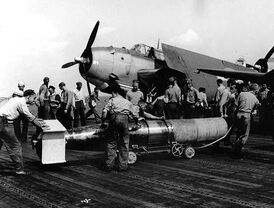
An Mk XIII Torpedo being loaded onto a TBF Avenger aboard USS Wasp, 1944.[1]
The Mk XIII or Mk. 13 was an airborne torpedo that was used by the United States during WWII. It could be dropped from a height of up to 234 meters and still hit its target successfully. This was made possible by special drag rings and a wooden stabilizer.[2]
History[]
Developed by the U.S. Navy weapons station at Newport, Rhode Island, the Mk XIII served as the United States' standard aerial torpedo in World War II. Thirteen feet long and 22.4 inches in diameter, a combat-ready Mk XIII weighed about 2,200 lbs, including 600 lbs of Torpex high explosive. In the water, it traveled at 33.5 knots (39 mph) to a maximum distance of 6,300 yards, and the flow of water turned an impeller beneath the nose, which armed the firing mechanism. Other countries' aerial torpedoes tended to be smaller and lighter than the Mk XIII, allowing them to be dropped at a higher altitude and airspeed. If dropped from a height of greater than 50 feet or at an airspeed faster than 110 knots (126 mph), the early versions of the Mk XIII tended to break up.
Although primarily used by the U.S. Navy, Mk XIII torpedoes were also used the U.S. Army Air Forces. On June 4, 1942, six Navy TBF-1 Avenger torpedo planes and four modified USAAF B-26 Marauders launched from Midway Island to attack the Japanese aircraft carriers during the Battle of Midway. Only one TBF-1 and two B-26s survived, and none of their torpedoes hit a Japanese ship.
When other B-26 units in the Aleutian Islands, the Southwest Pacific, North Africa, and the Mediterranean achieved little operational success against enemy shipping with Mk XIIIs, the USAAF abandoned aerial torpedoes in favor of the highly successful "skip bombing" technique.[3]
